Top Ten Best Species/Genus of Carnivorous Plants
Flesh-eating plants, pretty strange, right? While most plants are food for animals, these plants are predators for certain animals. Each of these plants have special features used to trap animals they eat (usually insects)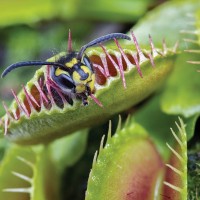
Venus flytrap (Dionaea muscipula) is a species of carnivorous plant native to subtropical wetlands on the east coast of the United States in North and South Carolina
This plant has a structure shaped like a bear trap that can be opened and closed. The inside part of the structure is covered with sensory hair. If in insect or arachnid touches one of the hair, the trap will close, trapping the insect or arachnid inside and enzymes will digest it
I had a Venus flytrap once. It died because it didn't thrive in temperate environments and didn't eat much insects. Plus, always water your Venus flytrap.
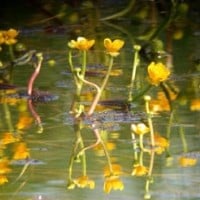
Commonly known as bladderworts. They're either terrestrial or aquatic, and are found in every continent except Antartica
They're the only known carnivorous plants that have bladder traps. Their traps are usually very small, and they can only catch very small preys like Protozoa. The larger traps can trap larger preys like fleas and sometimes small tadpoles. When prey is close enough, the plant will open its "door" to suck in the prey, and close it again. This process happens very fast, less than a second
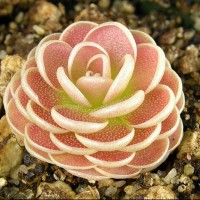
Commonly known as butterworts. They're found throughout North and South America, Europe, and Asia
These plants use their sticky bright green or pinkish leaves to trap insects. While the insect is stuck on the leaf, enzymes on the leaf will digest them
Many species aren't carnivorous during winter, but there are some species that are carnivorous all year
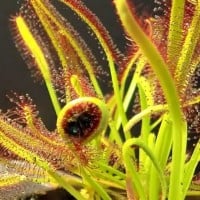
Commonly known as sundews. They're found on all continents except Antartica
These plants have tentacles, each tentacles have a tip covered in sweet, sticky liquid. When an insect lands on the tentacles, it will be stuck there, and more tentacles will cover it, and enzymes will digest the insect
This genus is one of the largest genus of carnivorous plants known, with at least 194 species
You mean a sundew? Or am I confusing the pic
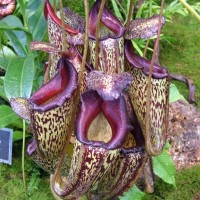
Commonly known as tropical pitcher plants. They're found in China, Malaysia, Indonesia, Philippines, Madagascar, Seychelles, Australia, India, Borneo, and Sumatra
These plants have pitfall traps. They each have a structure above that prevents raindrops to fall inside their trap (but sometimes raindrops are still able to enter the trap). The colors and the nectar-like smell produced by these plants attract insects. Insects will fall inside the trap and digested by enzymes
The largest species, Nepenthes Rajah and Nepenthes Rafflesiana, have been known to trap small mammals like mice too. These plants were given the nickname "monkey cup" because sometimes monkeys drink rain water that are trapped inside their traps
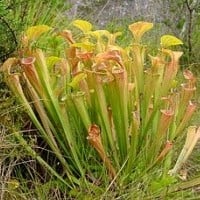
Commonly known as North American pitcher plants. Most species are found in the eastern seaboard
These plants are similar to the genus Nepenthes, but the difference is, plants from this genus stick on the ground and are longer and shaped like pipes, while plants from the genus Nepenthes hang from a tree
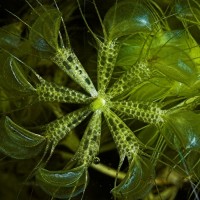
Waterwheel plant (Aldrovanda vesiculosa) is a species of aquatic flowering carnivorous plant native to Europe, Asia, Africa, and Australia
Its trap is similar to the Venus flytrap's, but it's smaller and underwater since it's aquatic
This plant is extremely endangered
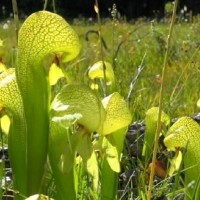
Cobra lily (Darlingtonia californica) is a species of carnivorous plant native to Northern Carolina and Oregon
This plant is species of pitcher plant. Once an insect enters the trap, it will close the exit hole and show false exit holes. The insect will get tired after trying many false exit holes, and fell to the trap
There's another species that shares the same technique of trapping preys, the parrot pitcher plant (Sarracenia psittacina)
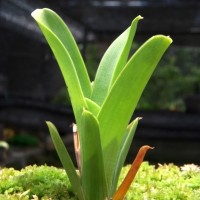
Brocchinia reducta is one of the few species of carnivorous bromeliad native to southern Venezuela, Brazil, Colombia, and Guyana
The leaves of this plant reflects ultraviolet light, which attracts insect. It has a water-storing cup, like other Brocchinia species. The water smells sweet, which attracts insects too. The Scales of the leaves are loose, which means it provides a poor foothold for the insect that landed on it. The insect that landed on a leaf will slip to the cup of water, drown, and digested by enzymes
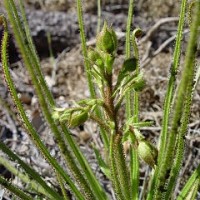
Drosophyllum is a genus of carnivorous plants native to Portugal, Spain, and Morocco
This plant is similar to the genus Drosera. It has glandular leaves which can be coiled, and those leaves are completely covered with sticky tentacles. When an insect lands on a leaf, it will be stuck there, and the leaf will coil, wrapping the insect
This genus only contains 1 species, Drosophyllum lucitanicum